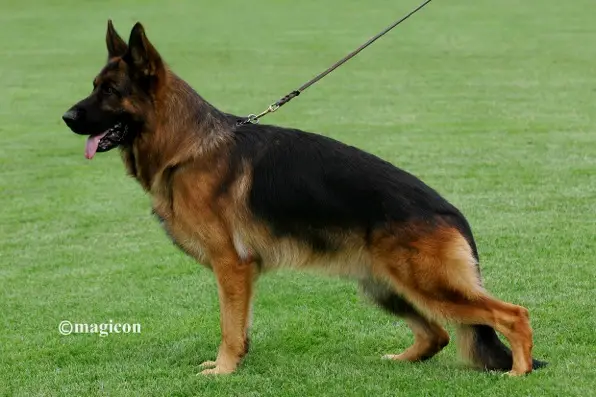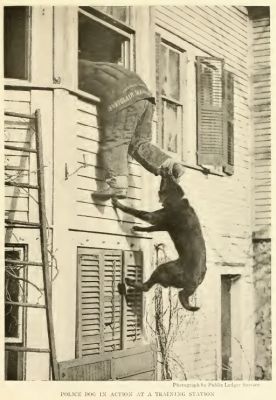
This is a placeholder text
Group text
by Ibrahim on 11 June 2012 - 05:06
It is clear to me where we differ and where we meet and that is okay and natural. I can't figure why we do not agree on the very basic thing, so here's a question we all need to answer:
What is it that the breed creator did new which was not available at his time?
My own answer: He created a new breed from existing dogs then, what is it that those dogs didn't have that made him decide to make a new breed? they had good work ability and temperament. They didn't have a uniform structure that is optimum for the work (at that time herding). So he worked on building up a new optimum form without loosing the work ability and temperament he was fiscinated with in those dogs available then, that is so simple in my opinion.
So to all of you who shared their opinions and views why don't you answer this question? Is it because the answer explodes the basis you built on your understanding of the breed and then the results you came up with and lived with for long?
Aby said: You talk about 'reach', but reach is really only a requirement for show, it actually serves no purpose.
Is it true that reach is only good for show? Aby the breed is and was built about the reach, all the angles, proportions and lengths of bones were designed for optimum reach which is equivalent to efficient movement and minimum waste of energy which results in optimum performance.
To argue that present structure is not the optimum is onething but to say that reach is useless is the most strange thing to be said by a GSD fan. No irrespect is intended here.
Please answer this: What is it the breed creator actually did that was different and new to the dogs of his time by creating the GSD?
Why do we put our dog in a stack and ask others to tell us what they think?
It's not only showlines are put in stack, also the worklines are stacked that way.
If one says that our time and current uses for dogs makes the reach useless and standard needs to be edited, that's a point of view for discussion but our breed is still about optimum physical performance plus temperament, showlines are doing fine in the first only and worklines are doing fine in the second only, both the lines need corrections if one's intention is to breed to the standard.
Ibrahim
by Abby Normal on 11 June 2012 - 06:06
Ibrahim, I have again to disagree, the breed was not 'built about the reach'. The GSD came into creation as the ultimate utility dog. Von Stephanitz did not set out with the intention of creating a dog with exceptional 'reach' - that was not the goal.
BTW, I love the natural gait of the GSD, but note again, I say 'natural' gait !
I never take offence at anything you say Ibrahim, as I know you are very respectful, and I know I surprised you by what I said LOL.
by Ibrahim on 11 June 2012 - 06:06
by Ibrahim on 11 June 2012 - 06:06
Please have a look at this young dog
http://www.pedigreedatabase.com/german_shepherd_dog/forum.read?mnr=630854
Just imagine he develops a little more fore chest and little more open and length to his front upper arm, his pedigree suggests correct temperament, this boy is what I think is a good form + temperament in one GSD.
Ibrahim
by Ibrahim on 11 June 2012 - 06:06
The German Shepherd Dog is also known as the Alsatian. It is handsome, well proportioned and very strong. It has a sturdy, muscular, slightly elongated body with a light but solid bone structure. Its head should be in proportion to its body, and the forehead a little convex. It has a strong scissors bite, ears wide at the base, pointed, upright, and turned forward (the ears of puppies under six months may droop slightly). The eyes are almond-shaped, never protruding, dark, with a lively, intelligent expression. Its bushy tail reaches almost to its hocks and hangs down when the dog is at rest. Its front legs and shoulders are muscular; its thighs thick and sturdy. It has round feet with very hard soles

by Ibrahim on 11 June 2012 - 07:06
by Gustav on 11 June 2012 - 11:06
Ibrahim, why do you think that they got rid of the 6 ft straight wall in Sch. They still use it in ring, they still use it in all police agility courses, the training regiments that really push the dog's utility (and the Malinois excel at) use straight walls without damage to the dog physically. There is really only one reason. You know show, I know utility and performance in this breed.....trust me the current structure of SL is not optimum for physical or utility work. Its not. Its just not between the ears when they fall short (in general, taking exceptions makes my point), but any longtime trainer of any performance/utility events will tell you the type of structure that excells at speed, strength, endurance, lateral movement, etc.....it is not the structure of SL. The WL structure is superior to SL for working, sport, and herding. That's why with 3 times more animals of the SL type in the world, you find 4 times more WL dogs in any endeavor that requires performance.
Abby is right, the SL emphasis is asthectic, but not made for functionailty other than going around the ring. And I am not just talking police, go to Agility trial and see the superior GS, the structure of the WL allows it to have speed and explosive power, that is needed for herding, police, agility, or sport. The Capn never in word or deed put the emphasis on reach or gait that he did on utility and moderation. He constantly drummed home the importance of utility, not reach and gait. Excessive gait and reach, take away from utitliy. If you want to say that today's dogs are more asthectically pleasing than earlier years....yes, if you want to say that today's dogs have more reach and better proportions to accentuate that reach/gait....yes. But these things do not transfer into excellence anywhere else outside of the showring or a pet home on a consistent basis.....and that's the reality of the situation. And I really don't think the Capn wanted the breed to be further developed into that direction....I could be wrong but it goes against everything he said and DID.
by darylehret on 11 June 2012 - 12:06
What is it the breed creator actually did that was different and new to the dogs of his time by creating the GSD?
Nothing. He was not a breed creator, but a registry creator, who selected from the dogs available of that time for their pre-existing characteristics. He was a man, not some god, and never known (by any account that I've read) as an accomplished breeder. More likely, a politician.
According to Lyon's book, "Dog in Action", German Shepherd breeders were not able to lengthen the body as necessary to allow for the "flying trot" until after 1930. What did Max ever say about the flying trot? Nothing, I bet. The "natural gait" did not exist in the seeply angulated, shorter coupled bodies used in show. But by then, showline breeders were already putting acute angulation on the hind legs, "and getting a tremendous drive that resulted in numerous side-wheelers or crab-runners."
The longer bodies that more frequently appeared after 1930 fixed the clipping and crab-running issues that were a result of the steeper angulations when paired with a shorter proportioned body length. Lyons was a WWI fighter pilot, and since he was from the time, I would assume his account bears accuracy.
by Markobytes on 11 June 2012 - 12:06
by Sunsilver on 11 June 2012 - 13:06
I'd provide a couple of videos to demonstrate this, but don't have time. However, if you look at the video of a SL's protection routine, someone posted earlier, you'll see him stumble during the first part of the drive.
As for REAL work, what modern SL would be capable of this?

Contact information Disclaimer Privacy Statement Copyright Information Terms of Service Cookie policy ↑ Back to top




